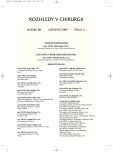Carcinoma in a Female Patient after Kidney Transplantation – A Case Review
Authors:
M. Vachtová; V. Třeška; B. Sůvová; O. Hes 1; D. Ebelenderová 2
Authors‘ workplace:
Chirurgická klinika FN a LF UK v Plzni, prof. MUDr. Vladislav Třeška, DrSc.
; Šiklův patologicko-anatomický ústav, prof. MUDr. Michal Michal
1; Radiodiagnostická klinika, doc. MUDr. Boris Kreuzberg, CSc.
2
Published in:
Rozhl. Chir., 2009, roč. 88, č. 11, s. 687-690.
Category:
Monothematic special - Original
Overview
Introduction:
Kidney transplantation improves the quality of life in patients with chronic renal insufficiency. Immunosuppression therapy has a significant impact on good quality long-term function of the transplanted kidney and on the long- term survival of the patients. However, long-term administration of immunosuppressives may be associated with a number of complications. These, in particular, include infectious events, as well as increased rates of malignancies in the population of transplantation patients, compared to normal population.
The median time of de novo breast carcinoma post- transplantation onset is approximately 56 months. Although studies have not confirmed its increased incidence rates, immunosuppression facilitates increased biological activity of the tumor and more frequent affection of axillary lymh nodes, resulting in reduced overall survival rates of the patients, compared to normal female population.
A Case Review:
The authors present a case review of a 65-year old female patient, who underwent transplantation of a cadaver kidney 7 years ago. Since then, the patient has been on immunosuppression therapy. For 8 years, the patient was screened in a breast care unit and was put on a waiting list for microcalcifications in her right breast, detected on mammography. In the Plzeň Faculty Hospital Surgical Clinic, the patient underwent surgery and was then referred to oncology. The kidney graft was functioning well and she was in a good overall condition, therefore, nephrologists did not indicate graphectomy. During the perioperative period, the patient’s condition was well controlled by immunosuppressives, and the patient continues with the medication during the postoperative period.
Conclusion:
The overall malignancy risk profile in a transplantation patient is defined by immunological, as well as non- immunological factors. These include the following: age, genetic factors, environmental factors, exposure to radiation or to solar radiation and smoking. Immunological factors include effects of immunosuppression medication on cellular imunity, effects on normal lymphoproliferation of cells providing tumor control, potential for development of cellular mutations and autonomic behavior of these cells, as well as effects on humoral immunity components, resulting in dysregulation of potentially malignant cellular mutations caused by viral infections.
It is impossible to prevent these malignancies, neither in the post-transplantation population, nor in the normal population. However, knowing principal risk factors, the general effort should be aimed at reducing their incidence and, in case of their occurrence, to establish the diagnosis in time and to initiate adequate treatment. Every patient who udergoes transplantation, must be considered at risk of malignancy development, therefore, increased oncological awareness should be employed and the patient should be enrolled in screening programmes, including regular clinical and laboratory check ups, which should include more extensive examination than that of the transplanted organ function only.
Key words:
breast carcinoma – kidney transplantation – immunosuppression therapy – risk factors
Sources
. Dantal, J. De novo post-transplantation malignancies: incidence and risk factors. Cancer Treat Res., 2009; 146: 11-21.
2. Buell, J. F., Hanaway, M. J., Trofe, J., Gross, T. G., Beebe, T. M., Alloway, R. R., First, M. R., Woodle, E. S. De novo breast cancer in renal transplant recipients. Transplant. Proc., 2002 Aug; 34(5): 1778–1779.
3. Haberal, A. N., Süren, D., Demirhan, B., Bilezikći, B., Celasun, B., Haberal, M. Evaluation of posttransplantation malignancies compared with de novo tumors. Transplant. Proc., 2007 May; 39(4): 1057–1062.
4. Vajdic, C. M., van Leeuwen, M. T. Cancer incidence and risk factors after solid organ transplantation. Int. J. Cancer, 2009 Oct. 15;125(8): 1747–1754.
5. Andrés, A. Cancer incidence after immunosuppressive treatment following kidney transplantation. Crit. Rev. Oncol. Hematol., 2005 Oct; 56(1): 71–85.
6. Gómez-Roel, X., León-Rodríguez, E. Malignant neoplasias in renal transplantation recipients. Rev. Invest. Clin., 2005 Mar-Apr; 57(2): 225–229.
7. Yang, T. C., Shu, K. H., Cheng, C. H., Wu, M. J., Lian, J. D. Malignancy following renal transplantation. Zhonghua Yi Xue Za Zhi (Taipei), 1998 May; 61(5): 281–288.
8. Veroux, P., Veroux, M., Puliatti, C., Amodeo, C., Makarone, M., Cappello, D., Cagli@, P. Early de novo neoplasia after renal transplantation. Tumori, 2003 Jul-Aug; 89(4 Suppl): 301–304.
9. Stratta, P., Morellini, V., Musetti, C., Turello, E., Palmieri, D., Lazzarich, E., Cena, T., Magnani, C. Malignancy after kidney transplantation: results of 400 patients from a single center. Clin. Transplant., 2008 Jul-Aug; 22(4): 424–427.
10. JAMA and Archives Journals (2006, December 20). Kidney Transplantation Linked With Increased Risk Of Various Cancers. ScienceDaily. Retrieved September 28, 2009. Dosputný na www.sciencedaily.com¬ /releases/2006/12/061219170712.htm.
11. John Wiley & Sons, Inc. (2005, September 27). Kidney Transplant Patients Face Higher Cancer Risk. ScienceDaily. Retrieved September 28, 2009. Dostupný na www.sciencedaily.com/releases/2005/09/050926074404.htm.
Labels
Surgery Orthopaedics Trauma surgeryArticle was published in
Perspectives in Surgery

2009 Issue 11
Most read in this issue
- Case Report: Fat Embolism Syndrome – Grave Handicap after Traumatic Long-bones Fractures
- Traumatic Brain Injuries – Effects of Alcohol and Coffein on Intracranial Pressure and Cerebral Blood Flow
- Pacient s entrapment syndrómom a. poplitea a infekčnou endokarditídou (kazuistika)
- Cervical Disc Arthroplasty (Prodisc-C): Analysis of 3 to 4- Year Follow Up Results
